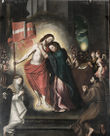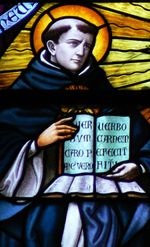John of the Cross
| Saint John of the Cross | |
|---|---|
 |
|
| Confessor and Doctor of the Church | |
| Born | 24 June 1542 Fontiveros, Spain |
| Died | December 14, 1591 (aged 49) Ubeda, Andalusia, Spain |
| Venerated in | Roman Catholic Church; Anglican Communion; Lutheran Church |
| Beatified | 25 January 1675 by Pope Clement X |
| Canonized | 27 December 1726 by Pope Benedict XIII |
| Major shrine | Tomb of Saint John of the Cross, Segovia, Spain |
| Feast | 14 December 24 November (General Roman Calendar, 1738-1969) |
| Patronage | contemplative life; contemplatives; mystical theology; mystics; Spanish poets |
Saint John of the Cross (San Juan de la Cruz) (24 June 1542 – 14 December 1591), born Juan de Yepes Alvarez, was a major figure of the Counter-Reformation, a Spanish mystic, Catholic saint, Carmelite friar and priest, born at Fontiveros, Old Castile.
Saint John of the Cross was a reformer of the Carmelite Order and is considered, along with Saint Teresa of Ávila, as a founder of the Discalced Carmelites. He is also known for his writings. Both his poetry and his studies on the growth of the soul are considered the summit of mystical Spanish literature and one of the peaks of all Spanish literature. He was canonized as a saint in 1726 by Pope Benedict XIII. He is one of the thirty-three Doctors of the Church. When his feast day was inserted into the General Roman Calendar in 1738, it was assigned at first to 24 November, since his date of death was impeded by the then existing octave of the Feast of the Immaculate Conception. This obstacle was removed in 1955 and in 1969 his feast day was moved to his date of death, 14 December.
Contents |
Life
Early life and education
St. John was born by the name of Juan de Yepes Alvarez[1] into a Jewish converso family in a small community near Ávila.[2] His father died when he was young, and so John, his two older brothers and his widowed mother struggled with poverty, moving around and living in various Castilian villages, with the last being Medina del Campo, to which he moved in 1551. [3] There he worked at a hospital and studied the humanities at a Society of Jesus (Jesuit) school from 1559 to 1563. The Society of Jesus was a new organization at the time, having been founded a few years earlier by the Spanish St. Ignatius Loyola. On 24 February 1563 he entered the Carmelite order, adopting the name Fr. Juan de Santo Matía.
The following year (1564) he professed as a Carmelite (was promoted from novice status) and moved to Salamanca, where he studied theology and philosophy at the University and at the Colegio de San Andrés. This stay would influence all his later writings, as Fray Luis de León taught biblical studies (Exegesis, Hebrew and Aramaic) at the University. León was one of the foremost experts in Biblical Studies then and had written an important and controversial translation of the Song of Songs into Spanish. (Translation of the Bible into the vernacular was not allowed then in Spain).
Priesthood and association with Saint Teresa of Avila
 |
|
Articles Early period 13-14th centuries 15-16th century 17-18th centuries 19th century 20th century |
Saint John was ordained a priest in 1567, and then indicated his intent to join the strict Carthusian order, which appealed to him because of its encouragement of solitary and silent contemplation. Before this, however, he travelled to Medina del Campo, where he met the charismatic Saint Teresa de Jesús. She immediately talked to him about her reformation projects for the Carmelite order, and asked him to delay his entry into the Carthusians. The following year, on 28 November, he started this reformation at Duruelo together with Fr. Antonio de Jesús de Heredia, and the originally small and impoverished town of Duruelo became a center of religion.
John, still in his 20s, continued to work as a helper of Saint Teresa until 1577, founding monasteries around Spain and taking active part in their government. These foundations and the reformation process were resisted by a great number of Carmelite friars, some of whom felt that Teresa's version of the order was too strict. Some of these opponents would even try to bar Teresa from entering their convents.
The followers of St. John and St. Teresa differentiated themselves from the non-reformed communities by calling themselves the "discalced", i.e., barefoot, and the others the "calced" Carmelites.
Imprisonment, writings, torture, death and recognition
On the night of 2 December 1577, John was taken prisoner by his superiors in the calced Carmelites, who had launched a counter-program against John and Teresa's reforms. John had refused an order to return to his original house, on the basis that his reform work had been approved by the Spanish Nuncio, a higher authority than John's direct superiors in the calced Carmlites.[4] John was jailed in Toledo, where he was kept under a brutal regimen that included public lashing before the community at least weekly, and severe isolation in a tiny stifling cell barely large enough for his body. He managed to escape nine months later, on 15 August 1578, through a small window in a room adjoining his cell. (He had managed to pry the cell door off its hinges earlier that day). In the meantime, he had composed a great part of his most famous poem Spiritual Canticle during this imprisonment; his harsh sufferings and spiritual endeavours are then reflected in all of his subsequent writings. The paper was passed to him by one of the friars guarding his cell.[5]
After returning to a normal life, he went on with the reformation and the founding of monasteries for the new Discalced Carmelite order, which he had helped found along with his fellow St. Teresa de Ávila.
He died on 14 December 1591, of erysipelas (cellulitis). His writings were first published in 1618, and he was canonized by Benedict XIII in 1726. In 1926, he was declared a Doctor of the Church by Pope Pius XI. When inserted into the Roman Catholic calendar of saints in 1738, his feast day was assigned to 24 November.[6] Pope Paul VI moved it to the dies natalis (birthday to heaven) of the saint, 14 December.[7]
The Church of England commemorates him as a "Teacher of the Faith" on the same date.
Literary works
St. John of the Cross is considered one of the foremost poets in the Spanish language. Although his complete poems add up to less than 2500 verses, two of them—the Spiritual Canticle and Dark Night of the Soul are widely considered to be among the best poems ever written in Spanish, both for their formal stylistic point of view and their rich symbolism and imagery .
The Spiritual Canticle is an eclogue in which the bride (representing the soul) searches for the bridegroom (representing Jesus Christ), and is anxious at having lost him; both are filled with joy upon reuniting. It can be seen as a free-form Spanish version of the Song of Songs at a time when translations of the Bible into the vernacular were forbidden.
Dark Night of the Soul (from which the spiritual term takes its name) narrates the journey of the soul from her bodily home to her union with God. It happens during the night, which represents the hardships and difficulties she meets in detachment from the world and reaching the light of the union with the Creator. There are several steps in this night, which are related in successive stanzas. The main idea of the poem can be seen as the painful experience that people endure as they seek to grow in spiritual maturity and union with God. A year after writing this poem, in 1586 he wrote a commentary on Dark Night of the Soul with the same title. This commentary explains the meaning of the poem verse by verse.
St. John also wrote four treatises on mystical theology, two treatises concerning the two poems above, which set out to explain the true meaning of the poems verse by verse and even word by word.
The third work, Ascent of Mount Carmel is a more systematic study of the ascetical endeavour of a soul looking for perfect union, God, and the mystical events happening along the way. A four stanza work, Living Flame of Love describes a greater intimacy, as the soul responds to God's love. These, together with his Dichos de Luz y Amor, or "Sayings of Light and Love," and St. Teresa's writings, are the most important mystical works in Spanish, and have deeply influenced later spiritual writers all around the world. Among these can be named T. S. Eliot, Thérèse de Lisieux, Edith Stein (Teresa Benedicta of the Cross), and Thomas Merton. John has also influenced philosophers (Jacques Maritain), theologians (Hans Urs von Balthasar), and pacifists (Dorothy Day, Daniel Berrigan, and Philip Berrigan). Pope John Paul II wrote his theological dissertation on the mystical theology of Saint John of the Cross. Saint John is also mentioned in Allen Ginsberg's groundbreaking poem Howl,[8] and is quoted by Jonas Mekas in his epic film-diary work 'Walden'.
See also
- Book of the First Monks
- Byzantine Discalced Carmelites
- Calendar of saints (Church of England)
- Carmelite Rule of St. Albert
- Christian Meditation
- Constitutions of the Carmelite Order
- Miguel Asín Palacios
- Saint Raphael Kalinowski, the first friar to be canonized (in 1991 by Pope John Paul II) in the Order of Discalced Carmelites since Saint John of the Cross
- Spanish Renaissance literature
- Secular Order of Discalced Carmelites
Books
- Dark Night of the Soul: A Masterpiece in the Literature of Mysticism (Translated and Edited by E. Allison Peers), Doubleday, 1959. ISBN 978-0-385-02930-8
- The Poems of Saint John of the Cross (English Versions and Introduction by Willis Barnstone), Indiana University Press, 1968, revised 2nd ed. New Directions, 1972. ISBN 0-8112-0449-9
- Dark Night Of The Soul, Saint John of The Cross (Translated by Mirabai Starr), Riverhead Books, New York, 2002, ISBN 1-57322-974-1
- Poems of St John of The Cross (Translated and Introduction by Kathleen Jones), Burns and Oates, Tunbridge Wells, Kent, UK, 1993, ISBN 0-86012-210-7
References
- ↑ Rodriguez, Jose Vincente, Biographical Narrative. God Speaks in the Night. The Life, Times, and Teaching of St. John of the Cross, Washington D.C.: ICS Publications, 1991, p. 3
- ↑ Norman Roth, Conversos, Inquisition, and the Expulsion of the Jews from Spain, Madison, WI: The University of Wisconsin Press, 1995, pp. 157, 369
- ↑ Matthew, Iain (1995). The Impact of God, Soundings from St John of the Cross.. Hodder & Stoughton. pp. 3. ISBN 0340612576.
- ↑ Bennedict Zimmermann. "Ascent of Mt Carmel , introductory essay THE DEVELOPMENT OF MYSTICISM IN THE CARMELITE ORDER". Thomas Baker and Internet Archive. http://www.archive.org/details/ascentofmountcar00johnuoft. Retrieved 2009-12-11. |pages = 10,11
- ↑ Dark night of the soul. Translation by Mirabai Starr. ISBN 1-57322-974-1 p.8.
- ↑ Calendarium Romanum (Libreria Editrice Vaticana, 1969), p. 110
- ↑ Calendarium Romanum (Libreria Editrice Vaticana, 1969), p. 146
- ↑ [1]
External links
- Catholic Encyclopedia on John of the Cross
- The Metaphysics of Mysticism: The Mystical Philosophy of Saint John of the Cross Biography of St. John of the Cross
- Christian Classics Ethereal Library: St. John of the Cross
- St. John of the Cross on the Mystical Site mysticism.nl
- Thomas Merton on St. John of the Cross
- Lectio divina and St John of the Cross
- The Life and Miracles of St. John of the Cross, Doctor and Confessor of the Church
|
|||||||||||||||||||||||||||||||||||||||||
|
||||||||||||||||||||||||||||||||||||||||||
|
|||||

